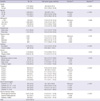1. Lai MS, Hsueh YM, Chen CJ, Shyu MP, Chen SY, Kuo TL, Wu MM, Tai TY. Ingested inorganic arsenic and prevalence of diabetes mellitus. Am J Epidemiol. 1994. 139:484–492.
2. Rahman M, Tondel M, Ahmad SA, Axelson O. Diabetes mellitus associated with arsenic exposure in Bangladesh. Am J Epidemiol. 1998. 148:198–203.
3. Coronado-González JA, Del Razo LM, García-Vargas G, Sanmiguel-Salazar F, Escobedo-de la Peña. Inorganic arsenic exposure and type 2 diabetes mellitus in Mexico. Environ Res. 2007. 104:383–389.
4. Jensen GE, Hansen ML. Occupational arsenic exposure and glycosylated haemoglobin. Analyst. 1998. 123:77–80.
5. Navas-Acien A, Silbergeld EK, Streeter RA, Clark JM, Burke TA, Guallar E. Arsenic exposure and type 2 diabetes: a systematic review of the experimental and epidemiological evidence. Environ Health Perspect. 2006. 114:641–648.
6. Chen CJ, Wang SL, Chiou JM, Tseng CH, Chiou HY, Hsueh YM, Chen SY, Wu MM, Lai MS. Arsenic and diabetes and hypertension in human populations: a review. Toxicol Appl Pharmacol. 2007. 222:298–304.
7. Navas-Acien A, Silbergeld EK, Pastor-Barriuso R, Guallar E. Arsenic exposure and prevalence of type 2 diabetes in US adults. JAMA. 2008. 300:814–822.
8. Longnecker MP, Daniels JL. Environmental contaminants as etiologic factors for diabetes. Environ Health Perspect. 2001. 109:871–876.
9. Ruiz-Navarro ML, Navarro-Alarcón M, Lopez González-de la Serrana H, Pérez-Valero V, López-Martinez MC. Urine arsenic concentrations in healthy adults as indicators of environmental contamination: relation with some pathologies. Sci Total Environ. 1998. 216:55–61.
10. Lamm SH, Engel A, Feinleib M. Arsenic exposure and diabetes mellitus risk. J Occup Environ Med. 2006. 48:1001–1003.
11. Zierold KM, Knobeloch L, Anderson H. Prevalence of chronic diseases in adults exposed to arsenic-contaminated drinking water. Am J Public Health. 2004. 94:1936–1937.
12. Wang SL, Chang FH, Liou SH, Wang HJ, Li WF, Hsieh DP. Inorganic arsenic exposure and its relation to metabolic syndrome in an industrial area of Taiwan. Environ Int. 2007. 33:805–811.
13. Chen Y, Ahsan H, Slavkovich V, Peltier GL, Gluskin RT, Parvez F, Liu X, Graziano JH. No association between arsenic exposure from drinking water and diabetes mellitus: a cross-sectional study in Bangladesh. Environ Health Perspect. 2010. 118:1299–1305.
16. Kim Y, Lee BK. Association between urinary arsenic and diabetes mellitus in the Korean general population according to KNHANES 2008. Sci Total Environ. 2011. 409:4054–4062.
17. Park HS, Park CY, Oh SW, Yoo HJ. Prevalence of obesity and metabolic syndrome in Korean adults. Obes Rev. 2008. 9:104–107.
20. American Diabetes Association. Diagnosis and classification of diabetes mellitus. Diabetes Care. 2011. 34:S62–S69.
21. Levy JC, Matthews DR, Hermans MP. Correct homeostasis model assessment (HOMA) evaluation uses the computer program. Diabetes Care. 1998. 21:2191–2192.
22. Wallace TM, Levy JC, Matthews DR. Use and abuse of HOMA modeling. Diabetes Care. 2004. 27:1487–1495.
23. Bland JM, Altman DG. Transformations, means, and confidence intervals. BMJ. 1996. 312:1079.
24. Yan LL, Liu K, Matthews KA, Daviglus ML, Ferguson TF, Kiefe CI. Psychosocial factors and risk of hypertension: the Coronary Artery Risk Development in Young Adults (CARDIA) Study. JAMA. 2003. 290:2138–2148.
25. Aposhian HV, Aposhian MM. Arsenic toxicology: five questions. Chem Res Toxicol. 2006. 19:1–15.
26. Sabbioni E, Fischbach M, Pozzi G, Pietra R, Gallorini M, Piette JL. Cellular retention, toxicity and carcinogenic potential of seafood arsenic: I. lack of cytotoxicity and transforming activity of arsenobetaine in the BALB/3T3 cell line. Carcinogenesis. 1991. 12:1287–1291.
27. Cleland B, Tsuchiya A, Kalman DA, Dills R, Burbacher TM, White JW, Faustman EM, Mariën K. Arsenic exposure within the Korean community (United States) based on dietary behavior and arsenic levels in hair, urine, air, and water. Environ Health Perspect. 2009. 117:632–638.
28. Cascio C, Raab A, Jenkins RO, Feldmann J, Meharg AA, Haris PI. The impact of a rice based diet on urinary arsenic. J Environ Monit. 2011. 13:257–265.
29. Mandal BK, Suzuki KT. Arsenic round the world: a review. Talanta. 2002. 58:201–235.
30. Nisianakis P, Giannenas I, Gavriil A, Kontopidis G, Kyriazakis I. Variation in trace element contents among chicken, turkey, duck, goose, and pigeon eggs analyzed by inductively coupled plasma mass spectrometry (ICP-MS). Biol Trace Elem Res. 2009. 128:62–71.
31. Walton FS, Harmon AW, Paul DS, Drobná Z, Patel YM, Styblo M. Inhibition of insulin-dependent glucose uptake by trivalent arsenicals: possible mechanism of arsenic-induced diabetes. Toxicol Appl Pharmacol. 2004. 198:424–433.
32. Díaz-Villaseñor A, Sánchez-Soto MC, Cebrián ME, Ostrosky-Wegman P, Hiriart M. Sodium arsenite impairs insulin secretion and transcription in pancreatic beta-cells. Toxicol Appl Pharmacol. 2006. 214:30–34.









 PDF
PDF ePub
ePub Citation
Citation Print
Print


 XML Download
XML Download